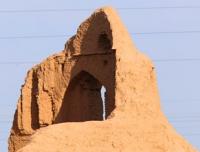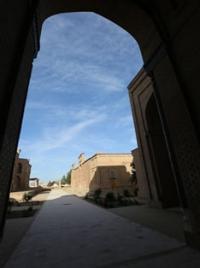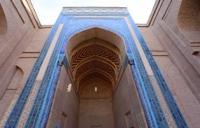Вы здесь
Sultan Saodat сomplex.



Main tourist attractions in Termez.
“History is practically only a journal of registration of crimes, stupidities and misfortunes of humanity”
Edward Gibbon.
The best sights in Termez in 2019.
|
|
|
|
The cult-memorial complex of Sultan Saodat is a very famous and popular place with tourists who travel to Uzbekistan. It is one of the most significant monuments in Termez. It was developed during the period of XI - XVII c.c. at the possessions of the Termez sayyids.
Cult-memorial complex, composed during the XII-XVII centuries. Burials at the influential dynasty Seyyids Termez. The original core of it - two mausoleums (XII century.) Combined deep vaulted aivan, who played the XV century. role memorial mosque: its end wall is the mihrab.
Both the mausoleum - centric compositions, spacious covered domes on octagonal arches and arched sails. Burnt brick, and serves as a constructive and decorative materials (bricks, masonry pairs, "a tree", insert, and wraps of hewn blocks figuratively).
Both mausoleums crowded headstones, some remnants of tiled decor. At the beginning of the XV century. portal are increasing in height and cause the lining of the new bright colorful majolica tiles. In the second half of XV century.
Both mausoleums were erected in front of two new, laminated construction in XV - XVII centuries. two parallel rows. Also, some new mausoleums were also mutually connected by an intermediate or ad-wang lobby, decor for them anymore.
In his final composition of Sultan Saodat appears as an ensemble of buildings grouped around the perimeter of a long narrow yard. This complex consists of several buildings which were added there at different time. During Uzbekistan tour you’ll see different mausoleums, mosques and hanagoh, built in the similar way, based on combination of integral and short compositions.
The most ancient part of this structure is the southwest part of the complex. In this place two large mausoleums are situated. They are joined with a terrace with a mihrab (the niche in a mosque showing the direction of Mecca) placed between them.
It was probably used as a funeral prayer place. It would be very interesting to include this place in Uzbekistan tour. Archeologists dated this ancient group to the XI - XII c.c. or the middle of XI c. While Uzbekistan tour you’ll know that this structure is non-typical.
It’s important to note, who is going to Uzbekistan, that this -unusual type of diamond-shaped base was used at the beginning of the XV c. The same diamond-shaped base you can see in the interior of the hanaqoh complex of Hakim at-Termizi during Uzbekistan tour.
This method, which we observed only in Termez during our Uzbekistan tour, was one of the peculiarities of its architecture. Because of clear solutions to the problems of structure, decor and volume, the mausoleums gained strict, highly artistic architectural appearance.
The unity of the construction is accented by decorative baked brick, which beautifully decorates the surface of the wall in the different forms. In the form of plain "ribbon", "fir tree" and "belt" patterns.
The wall of the mausoleum had an octahedron tier of arched sails on which was set a large dome. The crypts with their eastern facades bordered with the courtyard and had the same decoration.
Each facade was decorated with three flat arched bays in rectangle frames. The architrave, which was decorated with carved details, strengthened to three-quarter columns. They were set up on highly original bases, where at the expense of cutting angles of the prism of the bases of the facade part there appeared the effect of a cube fixed up on the rib.
The upper part of the arched bay to level five was clad in the form of "fir tree". The northern mausoleum was designed with luxurious decor. This one was decorated richer than the southern one. Here, all four walls had the same decoration of arrow shaped bays in a rectangle panel.
These arches were set on three-quarter cylindrical columns decorated with a line of carved rhombus, rings etc. The bosom of the sails are in the form of a spherical half-dome, upper bay rose to the fifth level of arches, and the arched bays located under the dome over angles of octahedral tiers over-clad in the form of a fir tree, which are intensified on the background of wall cladding.
During your Uzbekistan tour you’ll see that southern mausoleum with its 9m. Side had a stair built in its thick western wall leading to the roof of a terrace joined to it. Within the period of XIV - XV c.c. the portal of the terrace was built on the height and faced with multi-colored glazed decoration.
But unfortunately it has been lost. Besides, to the eastern facade of the mausoleum a one-chambered square room was built. Further, the composition of the ensemble was developed along the line of the west-east wall by the erection of new construction on the elongated sides of the courtyard.
As you’ll learn during your Uzbekistan tour all of these constructions repeat the idea of the ancient group of the build-versions, three-stage with an open terrace in the centre of the opened frontal facade. These were groups of mausoleums built in different sizes and at a different time from the north and south sides of the corner yard in the XVI - XVII.
From the west part of the courtyard there was a portal entrance. The magnificent ensemble was distinguished for its ancient group of mausoleums, homogenous in composition and decor though built in different style. And it is interesting to visit this place during Uzbekistan tour to absorb into ancient Oriental mystery.
Kokildor-Ota Mausoleum - Termez, UzbekistanThe Kokildor-Ota is very uncommon building. It mentioned by researchers for its architecture and unusual planning, as a khanaka mausoleum of the XVI c. worthy to note.
And it’s necessary to visit this place when you travel to Uzbekistan. Visitors traveling around Uzbekistan consider Kokildor-Ota a true epitome of ancient Oriental mystery, because there is very interesting story about this place.
The legend says that the name of the saint buried witnesses about his participation in the rite of cutting the tuft of hair of some believers who gave a vow to the tuft of hair till the time when some definite events took place in their life.
Kokildor-Ota is portal-domed construction, with many chambers and brick wall on the front. Making Uzbekistan tour you’ll see, that the idea of building a three-stage frontal, open facade, which was used in the complex of Sultan- Saodat, was repeated here too.
Its plan was symmetrical by composition: There was a deep terrace with a main entrance and large hall with a dome in the center. On their sides, almost parallel, were placed two rooms across the corridor in a mirror composition.
So, the rectangular entrance led to a central hall and lateral entrances to the joined rooms and corridors that were laterally to them. There are amazing patterns made of ganch. During Uzbekistan tour you’ll probably notice that the portal of this building was more characteristic for the Temurid epoch (XV c.) than to the architecture of Mawarannahr in the XVI c.
Archeologists have suggested that it could have been redecorated in the epoch of Temurids. In There are gravestones in the interior of the hall; the largest one belonged to Kokildor- Ota. Probably the reconstruction of the monumental structures was done at the same time with the complex of Hakim at- Termizi and Sultan Saodat.
It’s necessary to note for every tourist, who visits Uzbekistan, that Kokildor- Ota is significant monument in Termez and more than that it is one of the few khanaka with a frontal composition in Central Asia! And every man who travels to Uzbekistan.
Authority:
«The Guidebook on historical and cultural places of interest of the Surkhan-Darya area and the city of Termez». 2011.
Photos
Alexander Petrov.







